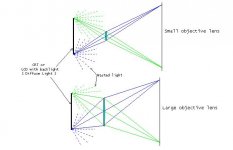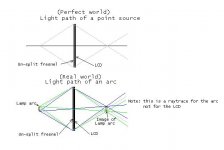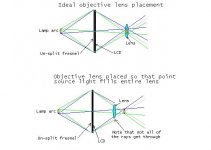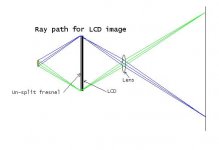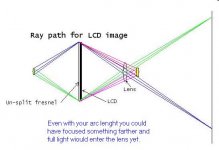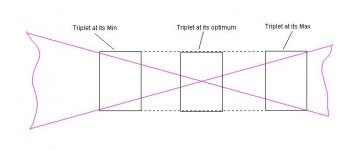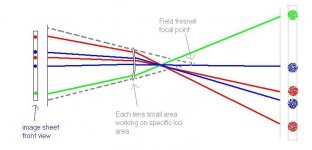TwoSpoons said:Every optics theory book I've read says that for projection systems the idea of the condenser (the fresnel in this case) is to create an image of the light source at the aperture of the objective lense. This is to get the best light throughput, and even field illumination of the slide (lcd in our case).
thats what i think as well. But we are arguing about it.
actually i wouldn´t say that the fresnell creates an image on the lens. I would say that the fresnell only redirects the light so most of it goes where we want, but the image on the lcd has not been altered by the fresnell. if you look to it from the focal point of the fresnell, you´ll see it perfectly, any other view point will not give you full lcd image.
The teorical setups of our projectors are based on lens projection. Mean thats the most important element. (you can do a proyection with only a lens element and nothing else (crt tv projectors for instance). So the setup based on "pinhole" are not correct if you use projection lens.
I would like to claryfy this since the ideal fresnell lens told to 3dlens owner was based on this teorical setup, and i wouldn´t like to be a mistake. This oportunity is unical so lets do it ok.
do you agree with me?
lamp distance
My discussion assumes that you place the lamp arc at the focal distance of the condensor fresnel. If you use a 330 mm fl condensor fresnel and no pre-condensor lens, then the lamp arc should be 330 mm from the fresnel.
If you do use a pre-condensor lens, then the lamp arc goes closer. But it still has to look like the light is coming from a point 330 mm from the fresnel.
You can play around with the lamp spacing just a bit (1-2 cm) to adjust the location of the arc image. If you move it much more than that you get a very badly lit LCD. Dim and uneven. At least that is what I have seen with my LL 220 mm fl condensor fresnel.
My discussion assumes that you place the lamp arc at the focal distance of the condensor fresnel. If you use a 330 mm fl condensor fresnel and no pre-condensor lens, then the lamp arc should be 330 mm from the fresnel.
If you do use a pre-condensor lens, then the lamp arc goes closer. But it still has to look like the light is coming from a point 330 mm from the fresnel.
You can play around with the lamp spacing just a bit (1-2 cm) to adjust the location of the arc image. If you move it much more than that you get a very badly lit LCD. Dim and uneven. At least that is what I have seen with my LL 220 mm fl condensor fresnel.
i agree with you, but moving the lamp from the focal point of the rear fresnell is needed when the field fresnell is long/short with the desired focal so this can be adjusted from the lamp placement.
since we can chosee the ideal focal (thats the idea of the trhead) we can work it out but there is estill a confusion on how the design needs to be.
do you still go for focusing at the center of the lens?
since we can chosee the ideal focal (thats the idea of the trhead) we can work it out but there is estill a confusion on how the design needs to be.
do you still go for focusing at the center of the lens?
i think focusing beyond do full area is used is ok because the each lens small area works for correspondent lcd area and this way the image is better.
i´ll try to xplain it;
lot of OHP are based on singlet lens because it is sufficent if the setup is ok. Mean the cuality is sufficent for sheet trasparencies;
this would be a OHP setup, focusing the light beyond the lens so full area is used (check that each lcd part would only hit the correspondent lens part and no other, lets call it unidirectional light source) the projected image is best.
now lets see what would happen if homnidirectional light source is used;
this could be a crt light source, each image point will hit full lens area (and more will be lost out of the lens area) so the each small lens area needs to work on full image source and then project all images one on the wall, like adding all of them (one on top to next....))
this projected image will be blurry.
I think this is the idea of fulling the lens area with the unidirectional ligh cone (fresnells will do that), so 1)full light goes where we want and 2)lens cuality is best as well as image cuality.
i´ll try to xplain it;
lot of OHP are based on singlet lens because it is sufficent if the setup is ok. Mean the cuality is sufficent for sheet trasparencies;
An externally hosted image should be here but it was not working when we last tested it.
this would be a OHP setup, focusing the light beyond the lens so full area is used (check that each lcd part would only hit the correspondent lens part and no other, lets call it unidirectional light source) the projected image is best.
now lets see what would happen if homnidirectional light source is used;
An externally hosted image should be here but it was not working when we last tested it.
this could be a crt light source, each image point will hit full lens area (and more will be lost out of the lens area) so the each small lens area needs to work on full image source and then project all images one on the wall, like adding all of them (one on top to next....))
this projected image will be blurry.
I think this is the idea of fulling the lens area with the unidirectional ligh cone (fresnells will do that), so 1)full light goes where we want and 2)lens cuality is best as well as image cuality.
if someone has a singlet lens from a OHP, he can try it in front of the CRT TV. The image with the OHP setup is much better than the crt with the same projection singlet lens.
Now a triplet lens and a unidirectional image source (fresnell fitting the lens perfectly) is the best quality. The same triplet on a crt tv will give us worse image quality.
Now a triplet lens and a unidirectional image source (fresnell fitting the lens perfectly) is the best quality. The same triplet on a crt tv will give us worse image quality.
This is because a CRT produces diffuse light and the singlet doesn’t collect as much light as it can from the OHP.if someone has a singlet lens from a OHP, he can try it in front of the CRT TV. The image with the OHP setup is much better than the crt with the same projection singlet lens.
Again this is from the diffuse CRT and to make it worse the triplet is physically longer, making it block even more light.Now a triplet lens and a unidirectional image source (fresnell fitting the lens perfectly) is the best quality. The same triplet on a crt tv will give us worse image quality.
Rox I think you are confusing the LCD imaging with the light path. We have to consider two goals here. One is the objective lens and it’s ability to focus the LCD the other is how we steer the light so that it all goes through the objective lens. Have a look at the following pics.
This first one show how light is collected from a diffuse light source. The rays from the pixels travel out in all directions. The two raytraces shows the difference of a small and large objective lenses ability to collect light. Note that the large lens is able to collect more light than the smaller.
Attachments
Now here is why the light should focus at the centre of the objective lens. The bottom raytrace shows how the light will be blocked if the light is focused beyond the lens using the point source as the guide for placement. Also make sure that you understand that this is the raytrace for the lamps arc and not for the LCD image. Another thing to consider here is that a multiple lens such as a triplet will make this blocking of light even worse.
Attachments
Just perfect !!
I agree with you in all points. I agre about the homnidirectional crt sources as well, i have just posted the same pics as you, but the first one is not honmidirectional, is unidirectional.
But there is only some little things i would like to check;
you are posting pics of real world, with those arc lenghs. If you had no arc lenght (infinitesimal point) there would not lose any light.
Even with your arc images, you can focus something father with the fresnells, your last picture is using 60% of lens aperture.
I now in real world it is not going to be as far as i say to focus, but it isn´t going to be at the focusing at the center neither. It needs to be a midle point where the full arc is inside de lens aperture and the outer light rays are inside the lens aperture as well. I think this point is the best solution for REAL WORLD.
What do you think about doing something like; (fcenter+fperfect)/2?
How would you use lets say 200mm aperure 450mm focal singlet lens in your setup? could you tell me what field focal would you like to use?
I agree with you in all points. I agre about the homnidirectional crt sources as well, i have just posted the same pics as you, but the first one is not honmidirectional, is unidirectional.
But there is only some little things i would like to check;
you are posting pics of real world, with those arc lenghs. If you had no arc lenght (infinitesimal point) there would not lose any light.
Even with your arc images, you can focus something father with the fresnells, your last picture is using 60% of lens aperture.
I now in real world it is not going to be as far as i say to focus, but it isn´t going to be at the focusing at the center neither. It needs to be a midle point where the full arc is inside de lens aperture and the outer light rays are inside the lens aperture as well. I think this point is the best solution for REAL WORLD.
What do you think about doing something like; (fcenter+fperfect)/2?
How would you use lets say 200mm aperure 450mm focal singlet lens in your setup? could you tell me what field focal would you like to use?
quote:rox
if someone has a singlet lens from a OHP, he can try it in front of the CRT TV. The image with the OHP setup is much better than the crt with the same projection singlet lens.
DAZZLA :This is because a CRT produces diffuse light and the singlet doesn’t collect as much light as it can from the OHP.
I wouldn´t say it is just luminosity. Lets say we have two setups one based on OHP (fresnell fiting the lens just perfectly with no arc lenght) and a very bright crt, so bright that the lumens captured by the lens on the crt setup are exactly the same lumens captured by the OHP setup, but there is a difference on how the light comes from each source;
very bright CRT source is homnidirectional light (each "pixel" will iluminate full lens aperture area)
OHP setup image source is unidirectional (each "pixel" will iluminate the exclusive correspondent lens area)
you would say the projected image is the same on both cases?
The ohp setup would give better image in my opinion.
if someone has a singlet lens from a OHP, he can try it in front of the CRT TV. The image with the OHP setup is much better than the crt with the same projection singlet lens.
DAZZLA :This is because a CRT produces diffuse light and the singlet doesn’t collect as much light as it can from the OHP.
I wouldn´t say it is just luminosity. Lets say we have two setups one based on OHP (fresnell fiting the lens just perfectly with no arc lenght) and a very bright crt, so bright that the lumens captured by the lens on the crt setup are exactly the same lumens captured by the OHP setup, but there is a difference on how the light comes from each source;
very bright CRT source is homnidirectional light (each "pixel" will iluminate full lens aperture area)
OHP setup image source is unidirectional (each "pixel" will iluminate the exclusive correspondent lens area)
you would say the projected image is the same on both cases?
The ohp setup would give better image in my opinion.
Another thing to remember is that no aberration or distortion has been shown in these pics and these will need to be taken into account as well.
I’m not sure what you are trying to achieve by placing the lens at one of its limits. The optimal position in my opinion is having the light focused at the centre of the lens. This is optimal for both light going through and keeping distortions and aberrations low. Any other position is a compromise. The idea is to use as little of the lens surface as possible and in doing so you can use a smaller lens. Just think about it this way, as the light is focused to an ever-decreasing smaller point, from real world to perfect world, the need for a large lens size is decreasing to a theoretical point where the lens is so small that it is not needed.
DJ
I’m not sure what you are trying to achieve by placing the lens at one of its limits. The optimal position in my opinion is having the light focused at the centre of the lens. This is optimal for both light going through and keeping distortions and aberrations low. Any other position is a compromise. The idea is to use as little of the lens surface as possible and in doing so you can use a smaller lens. Just think about it this way, as the light is focused to an ever-decreasing smaller point, from real world to perfect world, the need for a large lens size is decreasing to a theoretical point where the lens is so small that it is not needed.
DJ
i don´t agree with your statement on that the lens is not needed.
I repeat that our setups are based on lens projection, so thats the most impotant elemnt.
You said that the lens could beplaced on a range that the light enters fully to the lens, but it is not correct, the lens needs to be placed only at ONE position for each throw and it is the lamp position or the fresnells focals what can be in a range of working ok.
your teory of focusing at center of the lens, does not care the aperture of the lens, mean that any lens larger than the arc lenght aperture would be a waste of money cos only the aperture of the arc lenght would be working.
Please could you tell me what field fresnell lenght would you use if you had 200mm diameter aperture 450mm focal singlet?
I repeat that our setups are based on lens projection, so thats the most impotant elemnt.
You said that the lens could beplaced on a range that the light enters fully to the lens, but it is not correct, the lens needs to be placed only at ONE position for each throw and it is the lamp position or the fresnells focals what can be in a range of working ok.
your teory of focusing at center of the lens, does not care the aperture of the lens, mean that any lens larger than the arc lenght aperture would be a waste of money cos only the aperture of the arc lenght would be working.
Please could you tell me what field fresnell lenght would you use if you had 200mm diameter aperture 450mm focal singlet?
For a 15” LCD and for a 2000mm throw, (20mm gap to lcd) un-split the ideal fresnel FL would be 600mmPlease could you tell me what field fresnell lenght would you use if you had 200mm diameter aperture 450mm focal singlet?
For a 15” LCD and for a 3500mm throw, (20mm gap to lcd) un-split the ideal fresnel FL would be 536mm
For a 15” LCD and for a 5000mm throw, (20mm gap to lcd) un-split the ideal fresnel FL would be 514mm
Just because the lens is 200mm diameter doesn't mean you have to use all of it
DJ
Dazzzla said:
Just because the lens is 200mm diameter doesn't mean you have to use all of it
DJ
it doesn´t care the lcd size if you focus the center of the lens.
if you are not using full aperture, why do you buy 135 triplet?
i guess 80triplet with 450 focal lenght would be much cheaper.
Sorry, I was going to include more information for min and max fresnel FL but I ran out of time.it doesn´t care the lcd size if you focus the center of the lens.
Yes lens selection is all to do with what is available and how much it will cost.if you are not using full aperture, why do you buy 135 triplet?i guess 80triplet with 450 focal lenght would be much cheaper.
DJ
- Status
- Not open for further replies.
- Home
- General Interest
- Everything Else
- The Moving Image
- Optics
- guy grotke question
